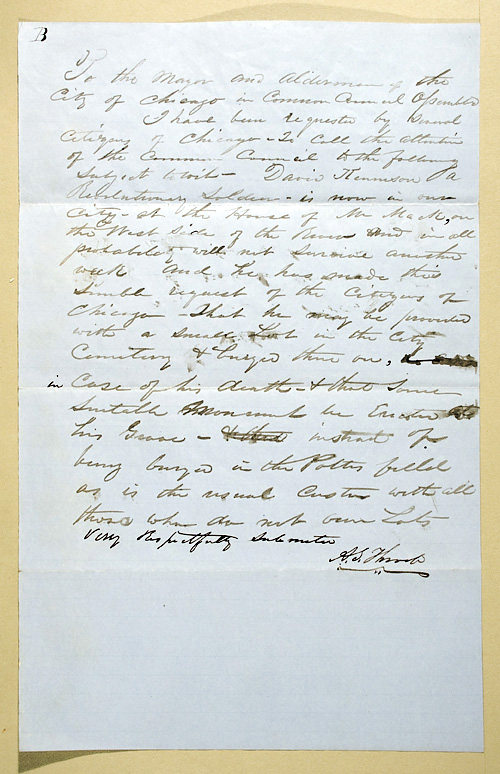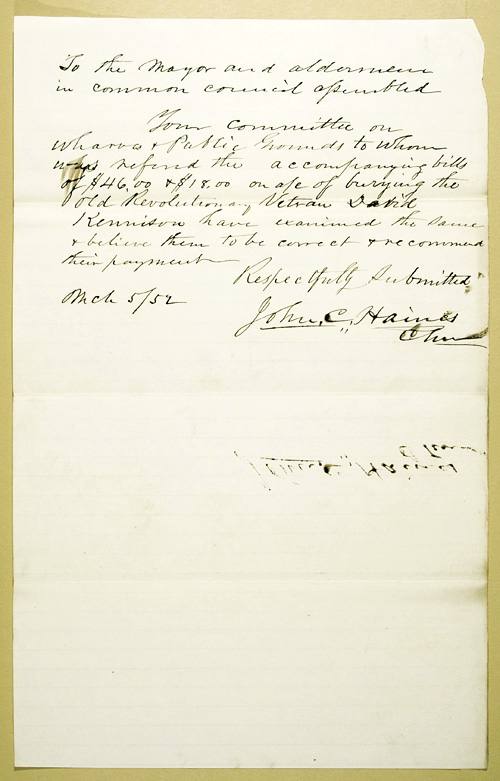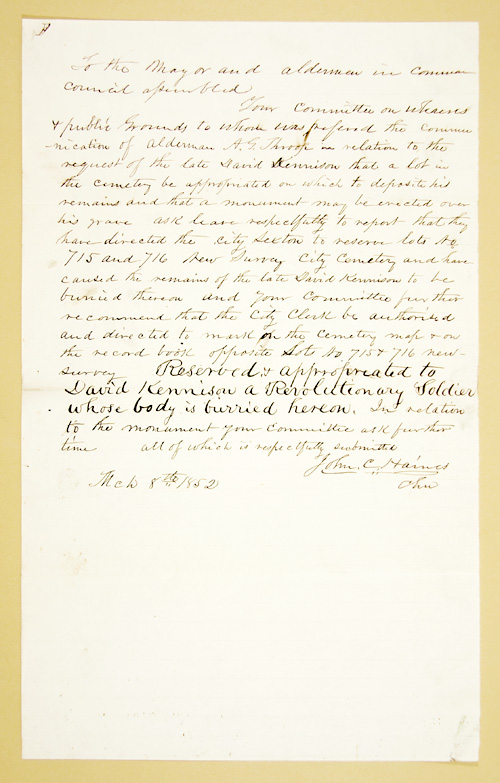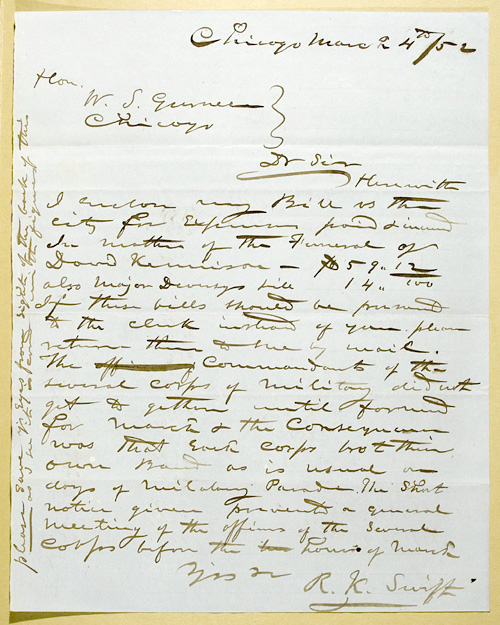 |
In early 1852, David Kennison made an appeal to Chicago's city officials, for accommodation in the City Cemetery.
This undated correspondence on Kennison's behalf, was presented to the Common Council by fourth ward alderman, A.G. Throop.
_______________________________
To the Mayor and Aldermen of the City of Chicago in Common Council Assembled
I have been requested by several citizens of Chicago – To call the attention of the Common Council to the following subject to wit – David Kennison a Revolutionary Soldier – is now in our City – at the House of Mr. Mack, on the West side of the River and in all probability will not survive another week and he has made this humble request of the Citizens of Chicago – That he may be provided with a small Lot in the City Cemetery & buryed there on, in case of his death - & that Some Suitable monument be Erected at his Grave – instead of being buryed in the Potters field as is the usual custom with all those who do not own Lots.
Very Respectfully Submitted
A.G. Throop
_______________________________
David Kennison died on February 24, 1852.
|
 |
Chicago Daily Journal, February 24, 1852
Died – In this city, February 24, at 9:00 a.m.
David Kinnison, aged 115 years.
------------
Chicago Daily Journal – February 25, 1852
Funeral of David Kennison
The death of this aged man has already been announced.
We perceive that the officers of the different military companies of the city have held a meeting and determined to consign the old soldier to his last resting place, with military honors.
Major Diversy is Chief Marshal and Adjutant Voss, Capt. W.H.Davis, Lieuts. Bacher and Gamble, Aids.
It was a motion resolved that the different military companies meet at the foot of Randolph Street, near Dearborn Park, at 3:00 o’clock this afternoon.
Lieut. Jones of the US Army, was invited to participate in the funeral ceremonies. The following is to be the order of procession:
1. Chief Marshal and Aids
2. Military Band with muffled drums. Firing Division.
3. Hearse, Bearers and Chaplain.
4. Chief mourners.
5. Military Companies in reverse order of rank.
6. Mayor and Common Council.
7. Clergy
8. Fire Department
9. Civil Societies
10. Citizens generally.
Returning, the military will march in proper order of rank to the place of rendezvous and then be dismissed.
Minute guns will be fired during the moving of the procession to the cemetery.
Funeral services will be held at the Clark street Methodist Church commencing at 2:00 o’clock, this afternoon.
By an act of the Council, a lot in the cemetery has been set apart for the reception of the remains of the deceased.
_________________________________________________
Two weeks after his death, a New York newspaper mentioned Kennison's passing, adding two years to his final age.
New York Evangelist, March 11, 1852

|
Chicago Daily Journal, February 26, 1852
Military Funeral Pageant.
Yesterday afternoon, the most imposing military pageant ever witnesses in this city, attended the consignment of the remains of the venerable David Kennison, a Revolutionary soldier and Pensioner, to the grave.
At two o’clock, the Clark Street Methodist Church was densely filled, and a discourse suitable to the occasion, was delivered by the Rev. Lewis Raymond of the Tabernacle Baptist Church.
The streets leading to the Church were filled with the military waiting to escort the old soldier to his last resting place. The side-walks were thronged, the windows and roofs of the adjoining buildings were filled with thousands of persons assembled to witness the imposing ceremonies.
The service in the church being concluded, the body was borned to the Hearse, by six officers acting as Pall Bearers, when the procession was formed in the following order:
1st. Major Diversy, as Chief Marshal, assisted by Adj.
Voss, Capt. W.H. Davis, Lieuts. Bacher and Gamble as aids.
2d. The Military Band, with muffled drums playing the
Dead March and other appropriate airs. It was
composed of the bands of the German, Washington
and Chicago German Battalions.
3d. The Hearse, appropriately decorated; at the side of
which walked six officers as bearers.
4th. The Chaplain, Rev. Mr. Raymond, and others of the
clergy in carriages.
5th. The chief mourners, also in carriages.
6th. The Mayor and Common Council of the city, also in
carriages.
7th. Lieut. Floyd Jones’s detachment of the United States
Army.
8th. A representation from the Fire Department,
composed of Engine Companies Number Five and Six, in uniform.
9th. Captain Swift’s fine Hussar Band, playing appropriate
airs.
10th. The independent military companies of the city, in
reverse order of rank.
They included the Montgomery Guards, and the German Companies; the whole closed by Capt. Swift’s Hussars and Light Artillery. The latter fired minute guns from one of their pieces, kept in reserve for the purpose, while the procession was on the march to the Cemetery.
The procession passed on – the mournful music along the line, swelling on the air. The multitude went their several ways, and the pageant was ended.
Arrived at the Cemetery, the usual military honors were paid, three volleys were fired over the old soldier’s grave, and in an hour, the Military came marching back, to lively music. The living had returned – the dead were left behind.
“So dies in human hearts, the thought of death.” |
 |
The city officials paid for David Kennison's funeral.
The record of the invoice, in the hand of John C. Haines, the fifth ward alderman, details those expenses, on the left.
__________________________________________
To the Mayor and aldermen in common council assembled
Your committee on Wharves & Public Grounds to whom was refered the accompanying bills of $46.00 & $18.00 on a/c of burying the Old Revolutionary Vetran David Kennison have examined the same & believe them to be correct & recommend their payment.
Respectfully Submitted
Mch 5/52
John C. Haines
Chm |
 |
After David Kennison's death, the Common Council considered the A.G. Throop plea on his behalf.
They committee acknowledged and resolved to place a monunent over Kennison's grave, but at the end of the report they left the matter open.
Note that it was David Kennison's suggestion in the Throop plea, to place a monument over his grave.
___________________________________
To the Mayor and aldermen in Common Council assembled
Your Committee on Wharves & public Grounds to whom was referred the communication of Alderman A.G. Throop in relation to the request of the late David Kennison that a lot in the cemetery be appropriated on which to deposit his remains and that a monument may be erected over his grave Ask leave respectfully to report that they have directed the city Sexton to reserve lots No. 715 and 716 New Survey City Cemetery and have caused the remains of the late David Kennison to be buried thereon and Your Committee further recommend that the City Clerk be authorised and directed to mark on the cemetery map & on the record book opposite Lots No. 715 & 716 new-survey
Reserved & appropriated to David Kennison a Revolutionary Soldier whose body is burried hereon. In relation to the monument your committee ask further time
all of which is respectfully submitted
Mch 8th 1852
John C. Haines
Chm |
 |
I am uncertain about the sources of the expenses incurred as listed in this invoice presented by R.K Swift. In the 1855 Chicago City Directory, Swift is listed as a banker.
It appears as if there there was some confusion with the military corps. Kennison's funeral may have been more of a spectacle than anticipated because of the number of military bands that arrived at a short notice.
_____________________________________
Chicago Mar 24th/52
Hon. W.S. Gurnee
Chicago
Dear Sir
Herewith I enclose my Bill to the city for expenses paid & incurred in matter of the Funeral of David Kennison - $59.12/100 also Major Diversys bill $14.. If these bills should be presented to the clerk instead if you please return them to me by mail.
The Commandants of the several corps of military did not get to gather until formed for march & the consequence was that each corps brot their own Band as is usual on days of Military Parade. The short notice given prevented a general meeting of the officers of the several corps before the hours of March.
R.K. Swift
[right edge]
Please save yr eyes from sight of the back of this as I see it is covered with figures. |